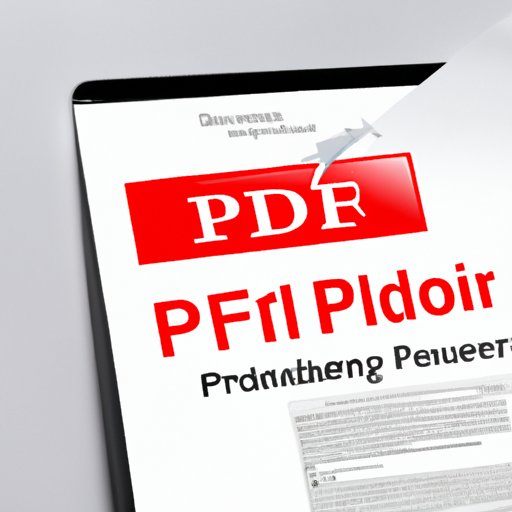
I. Introduction
A Portable Document Format, or PDF, is a type of digital file that is used to share and distribute documents in a way that is easy to read and print without compromising the original formatting. This file format has become increasingly popular due to its compatibility with all devices, making it essential for both personal and business use. In this guide, we will cover the necessary steps to create a PDF from scratch, including choosing the right PDF creator software, preparing your document, creating the PDF, verifying the quality and compatibility, as well as advanced PDF creation techniques.
II. Choosing the Right PDF Creator Software
When it comes to creating a PDF, choosing the right PDF creator software is essential. There are several options available on the market, each with its unique features and benefits. Some of the most popular options include:
- Adobe Acrobat
- Nitro Pro
- Foxit PhantomPDF
- CutePDF
When deciding which PDF creator software is right for you, consider the following factors:
- Compatibility with your device
- Cost
- Ease of use
- Security features
- Additional features, such as the ability to edit and merge PDF files
Based on these factors, we recommend Adobe Acrobat, which is compatible with both Windows and Mac operating systems, offers numerous security features, and a range of editing and merging capabilities.
III. Preparing Your Document
Before you create a PDF, there are several crucial steps you must take to ensure that your document is formatted and ready to be converted. Here are a few things to consider:
A. Formatting Considerations
Make sure that your document meets the file requirements for the PDF creator software you are using. This may include elements such as page size, margin sizes, font style and size, and page orientation. It is best to standardize certain elements of your document before beginning the conversion process.
B. Checking for Errors
Before you begin the conversion process, carefully proofread your document to check for any spelling, grammar, or formatting errors. This will save you time and prevent potential issues in the finished PDF.
C. Saving Your Document
Once you have formatted and proofread your document, save it in a format that is compatible with your PDF creator software. Common formats include Microsoft Word, Excel, or PowerPoint files, and image files such as JPEG or PNG.
IV. Creating the PDF
A. Open Your Desired PDF Creator Software
Once your document is saved, open the PDF creator software you have installed on your device.
B. Import the Document You Want to Convert to a PDF
In your PDF creator software, locate the option to “Create a New PDF,” and select the document you saved previously. Alternatively, you can drag and drop the document into the software interface.
C. Edit Your Document Accordingly (If Needed)
If you need to make any edits to your document, such as rearranging pages or adding comments, do so now using the editing tools available in your PDF creator software.
D. Review Your Document
Before converting, it is essential to review your document carefully to ensure that everything is accurate and formatted correctly. Make any necessary adjustments or edits as needed.
E. Save the PDF
Once everything is ready, select “Save” or “Export” to create your PDF document. You can choose the desired file name and location to export the finished document.
V. Verifying the Quality and Compatibility of Your PDF
A. Checking the Quality of Your PDF
After creating your PDF, it is essential to check its quality to ensure that it is readable and accurate. Open the PDF file and check to see if the formatting, graphics, text, and images are the same as the original document. If possible, print a copy to check the print quality and ensure there is no loss of quality when printed.
B. Ensuring the PDF is Compatible with All Devices
Prior to sharing or distributing your PDF, it is vital to ensure that it is compatible with all devices. Consider factors such as size, font style, and image resolution. To do this, test the PDF on several devices to ensure that it is readable and accessible.
C. Making Any Necessary Changes and Adjustments
If you find any issues with the quality or compatibility of your PDF, make any necessary changes and adjustments using your PDF creator software, then re-export the PDF.
VI. Advanced PDF Creation Techniques
A. Reducing PDF File Size
If you are working with a large file size, you may need to compress your PDF to reduce its size. To do this, select the option to “Optimize PDF” in your PDF creator software, then follow the prompts to adjust compression settings, image quality, and font embedding to reduce the file size without compromising quality.
B. Adding Password Protection or Digital Signatures
To protect sensitive information, consider adding password protection or digital signatures to your PDF. This will ensure that only designated individuals can access the information contained in the document.
C. Modifying Existing PDFs
If you have an existing PDF that needs modifications, you can use PDF creator software to edit, annotate, and add elements to your PDF document. Common tools for modifying PDFs include Adobe Acrobat and Nitro Pro.
VII. Conclusion
A. Recap of Crucial Steps to Create a PDF
In summary, to create a PDF from scratch, you will need to choose the right PDF creator software, prepare your document, create the PDF, verify its quality and compatibility with all devices, and explore advanced PDF creation techniques such as file compression and password protection.
B. Final Thoughts on the Importance of PDFs
PDFs are an essential format for sharing and distributing information, whether for personal or business purposes. Creating a high-quality PDF document requires careful preparation, attention to detail, and the right PDF creator software. By following the steps outlined in this guide, you can create PDFs that are accurate, readable, and accessible to all users, no matter the device.




